CTHULHU STUDIES
Tracking a new path to octopus and squid sensing capabilities
Research reveals that the octopus explores the marine environment with sensing features that are evolutionarily related to human brain receptors
Peer-Reviewed PublicationVIDEO: A CALIFORNIA TWO-SPOT OCTOPUS (OCTOPUS BIMACULOIDES) USES ITS ARM SUCKERS TO SECURE A FIDDLER CRAB. RESEARCH LED BY UC SAN DIEGO (HIBBS LAB) AND HARVARD UNIVERSITY (BELLONO LAB) HAS TRACED THE EVOLUTIONARY ADAPTATIONS OF OCTOPUS AND SQUID SENSING CAPABILITIES. THE STUDIES, FEATURED ON THE COVER OF THE APRIL 13, 2023 ISSUE OF NATURE, REVEAL EVOLUTIONARY LINKS TO HUMAN BRAIN RECEPTORS. view more
CREDIT: ANIK GREARSON AND PETER KILIAN
Along their eight arms, octopuses have highly sensitive suckers that allow methodical explorations of the seafloor as they search for nourishment in a “taste by touch” approach. Squids, on the other hand, use a much different tactic to find their next meal: patiently hiding until they ambush their prey in swift bursts.
In a unique analysis that provides a glimpse into the origin stories of new animal traits, a pair of research studies led by University of California San Diego and Harvard University scientists has traced the evolutionary adaptations of octopus and squid sensing capabilities. The studies, featured on the cover of the April 13 issue of Nature, reveal evolutionary links to human brain receptors.
Researchers with Ryan Hibbs’ newly established laboratory in the School of Biological Sciences at UC San Diego (formerly based at the University of Texas Southwestern Medical Center) and Nicholas Bellono’s lab at Harvard analyzed octopuses and squids, animals known as cephalopods, through a comprehensive lens that spanned atomic-level protein structure to the entire functional organism. They focused on sensory receptors as a key site for evolutionary innovation at the crossroads of ecology, neural processing and behavior.
By looking at the way octopuses and squids sense their marine environments, the researchers discovered new sensory receptor families and determined how they drive distinct behaviors in the environment. With cryo-electron microscopy technology, which uses cryogenic temperatures to capture biological processes and structures in unique ways, they showed that adaptations can help propel new behaviors.
“Cephalopods are well known for their intricate sensory organs, elaborate nervous systems and sophisticated behaviors that are comparable to complex vertebrates, but with radically different organization,” said Hibbs, a professor in the Department of Neurobiology. Hibbs brings expertise on the structure of a family of proteins in humans that mediate communication between brain neurons and other areas such as between neurons and muscle cells. “Cephalopods provide striking examples of convergent and divergent evolution that can be leveraged to understand the molecular basis of novelty across levels of biological organization.”
In one Nature study, the research teams described for the first time the structure of an octopus chemotactile (meaning chemical and touch) receptor, which octopus arms use for taste-by-touch exploration. These chemotactile receptors are similar to human brain and muscle neurotransmitter receptors, but are adapted through evolution to help evaluate possible food sources in the marine environment.
“In octopus, we found that these chemotactile receptors physically contact surfaces to determine whether the animal should eat a potential food source or reject it,” said Hibbs. “Through its structure, we found that these receptors are activated by greasy molecules, including steroids similar to cholesterol. With evolutionary, biophysical and behavioral analyses, we showed how strikingly novel structural adaptations facilitate the receptor’s transition from an ancestral role in neurotransmission to a new function in contact-dependent chemosensation of greasy environmental chemicals.”
The second Nature study focused on squid and their wholly different ambush strategy for capturing food. The researchers combined genetics, physiology and behavioral experiments to discover a new class of ancient chemotactile receptors and determined one structure within the class. They also conducted an evolutionary analysis to link adaptations in squid receptors to more elaborate expansions in octopus. They were then able to place chemotactile and ancestral neurotransmitter receptors on an evolutionary timeline and described how evolutionary adaptations drove the development of new behaviors.
“We discovered a new family of cell surface receptors that offer a rare lens into the evolution of sensation because they represent the most recent and only functionally tractable transition from neurotransmitter to environmental receptors across the entire animal kingdom,” said Hibbs. “Our structures of these unique cephalopod receptors lay a foundation for the mechanistic understanding of major functional transitions in deep evolutionary time and the origin of biological novelty.”
Hibbs says the pair of new studies offers an excellent example of how curiosity in interesting creatures can lead to insights important for all of biology, namely how proteins—life’s building blocks—adapt to mediate new functions and behaviors.
“These studies are a great example of what being a scientist is all about—wonder, exploration and understanding how things work,” he said.
Octopus chemotactile receptor (VIDEO)
Research led by UC San Diego (Hibbs Lab) and Harvard University (Bellono Lab) has traced the evolutionary adaptations of octopus and squid sensing capabilities. The research teams described for the first time the structure of an octopus chemotactile (meaning chemical and touch) receptor, which octopus arms use for taste-by-touch exploration. These chemotactile receptors are similar to human brain and muscle neurotransmitter receptors, but are adapted and evolved to help evaluate possible food sources in the marine environment.
CREDIT
Guipeun Kang
Research led by UC San Diego and Harvard has traced the evolutionary adaptations of octopus and squid sensing capabilities. The researchers describe for the first time the structure of an octopus chemotactile receptor, which octopus arms use for taste-by-touch exploration of the seafloor.
CREDIT
Anik Grearson and Peter Kilian
JOURNAL
Nature
METHOD OF RESEARCH
Experimental study
SUBJECT OF RESEARCH
Animals
ARTICLE TITLE
Sensory specializations drive octopus and squid behaviour
ARTICLE PUBLICATION DATE
12-Apr-2023


 Doryteuthis pealeii, often called the Woods Hole squid. Studies with D. pealeii have led to major advances in neurobiology, including description of the fundamental mechanisms of neurotransmission. The Marine Biological Laboratory collects D. pealeii from local waters for an international community of researchers. Credit: Roger Hanlon
Doryteuthis pealeii, often called the Woods Hole squid. Studies with D. pealeii have led to major advances in neurobiology, including description of the fundamental mechanisms of neurotransmission. The Marine Biological Laboratory collects D. pealeii from local waters for an international community of researchers. Credit: Roger Hanlon